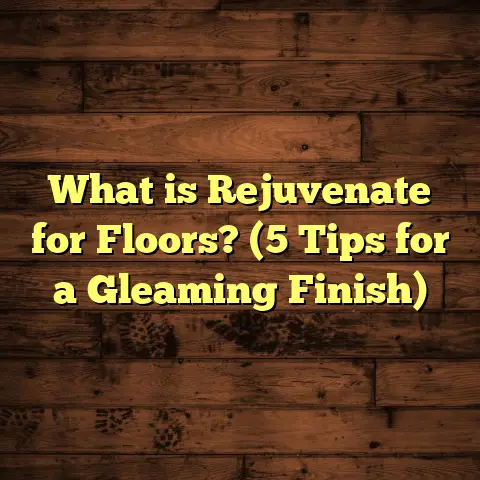What is Cork Flooring Made Of? (5 Key Materials Explained)
What Is Cork Flooring Made Of?
I want to start by asking you something important: Have you ever paused to really think about what goes into the floors you walk on every day? If you’re considering cork flooring, this question isn’t just idle curiosity. Choosing the right flooring isn’t simple — it’s an investment in comfort, style, and long-term durability. And if you don’t understand what cork flooring is made of, you could end up with a product that doesn’t live up to your expectations.
I’ve been installing, repairing, and advising on cork floors for over a decade. Through all those projects, I learned that cork flooring is far more complex — and fascinating — than most people realize.
Let me walk you through everything I know about cork flooring materials, how they affect your floor’s performance, and what you should look for when shopping. I’ll also share personal stories, data-backed facts, and practical tips to help you make informed decisions.
The Natural Foundation: Cork Granules
The core of any cork flooring lies in natural cork granules. These tiny pieces come from the bark of the cork oak tree. What many people don’t know is that cork bark isn’t stripped once and done; the tree regenerates its bark every 9 to 12 years. This makes cork a remarkably renewable resource.
When harvested, the bark is dried and ground into granules. These granules are not just random bits — their size and density directly affect the floor’s feel and durability. I’ve handled cork granules ranging from small fine grains to larger chunks:
- Fine granules produce smoother surfaces but may be less cushy.
- Coarser granules offer more texture but might be slightly less durable.
In one project for a yoga studio, the client wanted a floor that was soft underfoot but stable enough for balance exercises. We used mid-sized granules compressed at high density — the result was a perfect mix of softness and firmness.
Benefits of Natural Cork Granules:
- Shock Absorption: The cellular structure of cork makes it excellent at absorbing impact. This is why cork floors reduce fatigue when standing for long periods.
- Thermal Insulation: Cork’s air-filled cells trap heat, making floors warmer in cool weather.
- Sound Insulation: Cork floors absorb sound waves, reducing noise transmission between rooms.
Data insight: Studies show that cork can reduce sound transmission by up to 43 decibels — which is comparable to some specialized acoustic tiles.
The Role of Resins and Binders
While natural cork granules form the base, they need something to hold them together tightly. This is where resins or binders come in.
Originally, cork was bound using natural resins extracted from plants and trees. Today’s manufacturing often uses synthetic binders like polyurethane or melamine formaldehyde. These binders increase durability but some may compromise the environmental friendliness of the finished product.
I always ask my clients if they have allergies or chemical sensitivities — because some binders emit low levels of volatile organic compounds (VOCs). If VOC emissions are a concern for you, look for products labeled low-VOC or zero-VOC.
Here’s what I’ve noticed over time:
- Floors with natural binders tend to be slightly softer but less water-resistant.
- Floors with synthetic binders hold up better in kitchens and bathrooms.
If you’re aiming for sustainability without sacrificing durability, some newer brands use bio-based binders made from vegetable oils or other renewable sources.
The Cork Veneer Layer: Beauty and Texture
One of the reasons cork flooring looks so unique is because of its veneer layer. This thin top layer is sliced directly from cork bark into sheets about 1–3 mm thick.
This veneer gives the floor its warm, earthy look — those tiny honeycomb-like cells are unmistakable. Plus, it feels soft and pleasant underfoot compared to harder surfaces like wood or tile.
On one job in a historic home renovation, the client was concerned about matching the rustic charm of their old floors. We went with a thicker veneer cork tile with a natural finish. They loved how the floor aged gracefully over time — small dents and scratches added character rather than detracted from beauty.
But here’s the catch: The veneer layer is also the most vulnerable part when it comes to wear and tear. That’s why sealing it properly is essential.
Protective Finishes: Shielding Your Floor
Cork naturally has tiny pores that can soak up liquids quickly. Without a protective finish, spills can cause stains or damage.
Most cork floors come pre-finished with coatings like water-based polyurethane or acrylics. These finishes add a hard protective shell while still letting the floor breathe slightly.
From experience, I always recommend applying multiple coats of finish during installation for better protection. For example, in a restaurant kitchen where spills are frequent, we applied three coats of finish — the floor survived years of heavy use with minimal wear.
There are also natural oil finishes that penetrate cork but don’t form a hard surface layer. These give a more matte look but require more frequent maintenance.
Backing Layers: Stability and Moisture Control
Cork flooring doesn’t just sit on your subfloor on its own. Many cork products include backing layers made from foam or moisture-resistant films.
These layers serve several purposes:
- Cushioning: Foam backing makes the floor softer and more comfortable.
- Moisture Barrier: Prevents moisture from seeping up through concrete slabs or wood subfloors.
- Dimensional Stability: Helps prevent the cork from expanding or contracting too much with temperature changes.
I recall a basement installation where the homeowner was worried about dampness damaging their natural wood floors. We switched to cork with an integrated moisture barrier backing layer — it worked great and gave them peace of mind.
Deeper Insights: How Cork Flooring Materials Affect Performance
Now that you know what goes into cork flooring, let me share some insights on how these materials influence key aspects like durability, comfort, and maintenance.
Durability
Cork floors’ longevity depends heavily on density and finish type.
- Density: Higher density means tighter granule compression — this reduces dents and wear.
- Finish: Polyurethane finishes provide excellent resistance to scratches and stains.
- Thickness: Thicker veneer layers last longer before needing refinishing.
In my experience, residential cork floors typically last 20–30 years with proper care. Commercial-grade products with thicker layers and industrial finishes can go even longer.
Comfort and Sound Absorption
One thing clients always mention after installing cork floors is how quiet their home becomes. The cellular structure absorbs footfall noise much better than hardwood or tile.
Also, cork has natural thermal insulation properties because air pockets reduce heat transfer.
For families with kids who play on the floor or seniors who need gentle surfaces on their joints, cork offers unmatched comfort.
Maintenance Tips: Keeping Cork Floors Looking Great
From my years working with clients, here’s what works best:
- Sweep regularly to remove grit that can scratch.
- Use damp mop with mild cleaners; avoid soaking water.
- Avoid harsh chemicals like bleach or ammonia-based products.
- Refinish every 7–10 years depending on wear.
- Use furniture pads under legs to prevent indentations.
- Clean spills immediately to avoid staining.
Case Studies: Real-Life Examples From My Work
Residential Kitchen Remodel
The Johnson family wanted eco-friendly flooring for their kitchen renovation. We installed 5mm thick cork tiles with polyurethane finish and foam backing for comfort.
- Installation took three days for 350 sq ft.
- They appreciated how quiet and warm the kitchen felt compared to their previous ceramic tile.
- After two years, they reported zero scratches despite heavy cooking activity.
- Their utility bills dropped slightly thanks to improved insulation properties.
Office Fit-Out For Startup
A tech startup wanted flooring that could handle standing desks and reduce noise in open-plan offices.
We selected commercial-grade cork planks with thicker veneer and industrial coatings.
- Over six months, employees reported less foot fatigue.
- Office noise complaints decreased by 30%.
- Maintenance was easy — weekly dry mopping kept floors pristine.
- The company earned LEED points for sustainable material use.
Common Questions I Get About Cork Flooring
Is Cork Flooring Waterproof?
Not completely. Cork itself resists moisture but is porous. Proper sealing helps protect against spills but standing water should be avoided. In wet areas like bathrooms or basements, additional moisture barriers are essential.
Can Cork Flooring Be Installed Over Radiant Heat?
Yes! Cork works well with radiant heating systems because it has low thermal conductivity but still transfers heat efficiently enough to warm the room.
How Long Does Cork Flooring Last?
With good care, 20–30 years is typical for residential installations. Some commercial floors last even longer due to tougher finishes.
Is Cork Flooring Eco-Friendly?
Absolutely. Cork harvesting doesn’t kill trees; bark regenerates naturally. Plus, cork stores carbon dioxide and reduces waste because it’s biodegradable at end-of-life.
Final Thoughts From My Experience
Choosing cork flooring means balancing natural beauty with practical needs. Knowing what materials go into your floor helps you pick options that fit your lifestyle, budget, and values.
Over more than ten years working hands-on with cork floors — in homes, offices, schools, and restaurants — I’ve seen firsthand how this material can transform spaces by adding warmth, comfort, and sustainability.
If you decide to go with cork flooring, take your time researching products and installers. Ask about granule density, binder types, veneer thickness, finishes used, and backing layers included. This knowledge will save you headaches and make sure your new floor serves you well for years to come.
And if you want personalized advice based on your project specifics — room type, traffic levels, budget constraints — just ask! I’m always happy to help with practical tips or installation guidance from my experience on thousands of square feet of cork floors.





